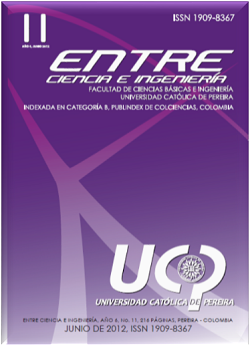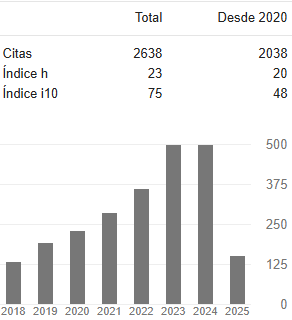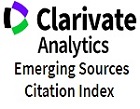Simulación de Propiedades Mecánicas de las Multicapas Duras Basadas en Ti mediante el Método de Elementos Finitos
DOI:
https://doi.org/10.31908/19098367.697Palabras clave:
propiedades mecánicas, estrés, nanoindentación, bicapasResumen
En este trabajo, se estudio el comportamiento mecánico de bicapas TiAlV/TiAlVN mediante experimentos de nanoindentación simulados con el uso del software ANSYS. En las simulaciones se consideró un indentador de diamante tipo Vickes, un sustrato de acero y bicapas TiAlV/ TiAlVN distribuidas en un espesor constante de 2 μm, en una geometría de eje simétrico. Los parámetros usados en la simulación como modulo de Young E, relación de Poisson ν y punto de fluencia σe para el TiAlV y TiAlVN fueron de 113.6 GPa ay 350 GPa, 0.342 y 0.2, y 830 MPa y 870 MPa respectivamente. Los resultados mostraron que la distribución de estrés radial presenta un comportamiento en forma de sierra y el máximo en el estrés de corte disminuye en la medida que el número de bicapas se incrementa.
Descargas
Referencias
Abdul-Baqui A., van der Giessen E., (2001). “Indentation-induced Interface Delamination of a Strong Film on a Ductile Substrate”, Thin Solid Films Vol. 381, pp. 143-154.
Amaya-Roncancio S., Restrepo-Parra E., (2008). “Finite Elements Modeling of Multilayers of Cr/CrN”, Microelect. J., Vol.39, pp. 1336–1338.
Bauer S., Schmuki P., van der Mark K., Park J., (2012). “Engineering Biocompatible Implant Surfaces, Engineering Biocompatible Implant Surfaces” Progress Mater. Sci., In Press.
Chawla V., Jayaganthan R., Chandra R. (2008). “Finite Element Analysis of Thermal Stress in Magnetron Sputtered Ti Coating”, J. mater. Proc. Technol., Vol. 200, pp. 205–211.
Chen X., Xiang Y., Vlassak J.J. (2006). “A Novel Technique of Measuring the Mechanical Properties of Porous Materials by Nanoindentation: with Application to Low-k Dielectric Thin Films”, J. Mater. Res. Vol. 21, No. 3, pp.715-724.
Cheng Y.-T., Cheng C.-M., (1998). “Further Analysis of Indentation Loading Curves: Effects of Tip Imperfection on Mechanical Property Measurements”, J. Mater. Res. Vol. 13, pp.1059-1065.
Cheng Y.-T., Cheng C.-M. (1999). “Scaling Relationships in Conical Indentation of Elastic-Perfectly Plastic Solids”, Int. J. Solids Struct., Vol. 36, pp. 1231-1243.
Cheng Y.-T., Cheng C.-M. (1999). “Can Stress–Strain Relationships Be Obtained from Indentation Curves Using Conical and Pyramidal Indenters?”, J. Mater. Res. Vol. 14, pp. 3493-3496.
Cheng Y.T., Cheng C.M. (2004). “Scaling, Dimensional Analysis, and Indentation Measurements”, Mater. Sci. Eng. R. Vol. 44, pp.91- 149.
Dao M., Chollacoop N., Van Vliet K.J. Venkatesh T.A., Suresh S. (2001). “Computational Modeling of the Forward and Reverse Problems in Instrumented Sharp Indentation” Acta Mater. Vol. 49, pp. 3899- 3918.
Doerner F., Nix W.D. (1986). “A Method for Interpreting the Data from Depth- Sensing Indentation Instruments”, J. Mater. Res. Vol. 1, pp. 601-605.
Efeoglu I. (1993). “The Mechanical and Tribological Properties of Ceramic Sputter Ion Plated Coating”, PhD Thesis, Dept. of Aero and Mech. Eng., University of Salford, UK.
Engineering tool box (October, 2012), http://www.engineeringtoolbox. Com
Fischer-Cripps AC. (2002). “Nanoindentation”. New York: Springer.
Gong J., Wu J., Guan Z., (1999). “Examination of the Indentation Size Effect in Low-load Vickers Hardness Testing of Ceramics”, J. Europ. Soc., Vol.19, pp 2625-2631.
He J.L., Veprek S., (2003). “Finite Element Modeling of Indentation into Superhard Coatings”. Surf. Coat. Tech. Vol. 163 –164, pp. 374– 379.
Hermann AJ, Hofmann S. (1987). “Surface and Interface Characterization of Heat-Treated (TiAl) N Coatings on High Speed Steel Substrates”, Proceedings, Inter. Conf. Metal. Coat., San Diego, CA, USA, pp. 23– 24.
Klein C. A., (1992). “Anisotropy of Young’s Modulus and Poisson’s Ratio in Diamond”, Mater. Res. Bull., Vol. 27. No.12, pp.1407-1414.
Knapp J.A., Follstaedt D.M., Barbour J.C., Myers S.M. (1997). “Finiteelement Modeling of Nanoindentation for Determining the Mechanical Properties of Implanted Layers and Thin Films”, Nucl. Instrum. Methods B, Vol. 127-128, pp 935-939.
Knapp J.A., Follstaedt D.M., Myers S.M., Barbour J.C., Friedmann T.A. (1999). “Finite-element Modeling of Nanoindentation”, J. Appl. Phys. Vol. 85, pp.1460-1474.
Knotek O, Munz WD, Leyendecker T. (1987). “Industrial Deposition of Binary, Ternary, and Quaternary Nitride of Ti, Zr, and Al”, J Vac Sci Technol, A, Vol. 5, pp. 2173–2179.
Lichinchi M., Leonardi C., Haupt J., Vitali R., (1998). “Simulation of Berkovich Nanoindentation Experiments on Thin Films Using Finite Element Method”, Thin Solid Films, Vol. 312, pp. 240-248.
Oliver W.C., Pharr G.M., (1992). “An Improved Technique for Determining Hardness and Elastic Modulus Using Load and Displacement Sensing Indentation Experiments”, J. Mater. Res. Vol. 7, pp. 1564-1583.
Poláková H., Musil J., Vlc¡ek J., Allaart J., Mitter C., (2003). “Structurehardness Relations in Sputtered Ti–Al–V–N films”, Thin Solid Films, Vol. 444, pp.189–198.
Randhawa H, Johnson PC, Curigham R. (1998). “Deposition and Characterization of Ternary Nitrides”, J Vac Sci Technol, A Vol. 6, pp. 2136–2139.
Sun Y., Bell T., Zheng S., (1995). “Finite Element Analysis of the Critical Ratio of Coating Thickness to Indentation Depth for Coating Property Measurements by Nanoindentation”, Thin Solid Films, Vol. 258, pp. 198-204.
Tang G., Shen Y.-L. Singh D.R.P., Chawla N. (2010). “Indentation Behavior of Metal–Ceramic Multilayers at the Nanoscale: Numerical Analysis and Experimental Verification”, Acta Mater. Vol. 58, pp. 2033–2044.
Tsui T.Y., Vlassak J.J., Nix W.D. (1999). “Indentation Plastic Displacement Field: Part I. The Case of Soft Films on Hard Substrates”. J. Mater. Res. Vol. 14, pp. 2196.
Vieira M.T., Ramos A.S., (1999). “The Influence of Ductile Interlayers on the Mechanical Performance of Tungsten Nitride Coatings”, J. Mater. Proc. Technol. Vol. 92-93, pp. 156-161.
Xie Z. H., Sing R., Bendavid A., Martin P., Munroe P., Hoffman M., (2007). “Contact Damage Evolution in a Diamond-Like Carbon (DLC) Coating on a Stainless Steel Substrate”, Thin Solid Films, Vol. 515, pp. 3196-3201.
Zhao, X., Xie, Z., Munroe, P., (2011). “Nanoindentation of Hard Multilayer Coatings: Finite Element Modeling”, Mater. Sci. Eng. A, Vol. 528, No. 3, pp. 1111-1116.
Descargas
Publicado
Número
Sección
Licencia
Derechos de autor 2019 Entre Ciencia e Ingeniería

Esta obra está bajo una licencia internacional Creative Commons Atribución-NoComercial 4.0.



















